Korea’s traditional musical instruments include native instruments that have been played since ancient times and foreign instruments adopted from the Eurasian continent. Throughout the nation’s long history, these instruments have encapsulated its culture and sensibilities, undergoing modifications to better express the sounds of different eras.
A nation’s musical instruments reflect its cultural contours. The materials, shapes, sizes and playing techniques that determine an instrument’s sound are an amalgamation of many elements, including geographical location, environment, culture and religion. And yet, nearly every instrument must be seen to possess qualities derived from outside the nation’s border; new instruments are born when the cultures of neighboring regions collide and converge. Hence the identity of an instrument is not fixed but rather constantly evolving.
Traditional Korean musical instruments are no exception to this ebb and flow. Some were imported from China many centuries ago. Some were picked up after they fell out of favor and given a second life in Korea. And some are versions of Western instruments that were adopted during the 20th century. Some instruments continue to be reformed today to improve their volume or expand their range. Iterations transcend barriers in redesigning their mien and sound.
In the modern era, as Western music spread to Korea, bands, quartets and orchestras became the primary musical performers. Traditional Korean instruments, not being very well suited to such ensembles, have been pushed to the side. In particular, instruments that produce a low volume or are difficult to use to play harmony are typically given a minor role.
Recently, however, more musicians are performing as soloists, sharing the distinct characteristics of their traditional instruments with audiences. New solo compositions are being written for instruments that were pushed far to the back as they were unable to reveal their original tone color in a group, as well as for instruments that were almost never played alone. Traditional instruments – and the whole genre of traditional music – are thus being interpreted and played in much more diversified ways. Today, traditional instruments are used in a broad array of music genres, from creative pieces focused on the grammar of traditional music to works that bridge genres.
In the following we take a look at some of the traditional Korean musical instruments that have been popular in recent years.
Geomungo
The Finest of All Instruments
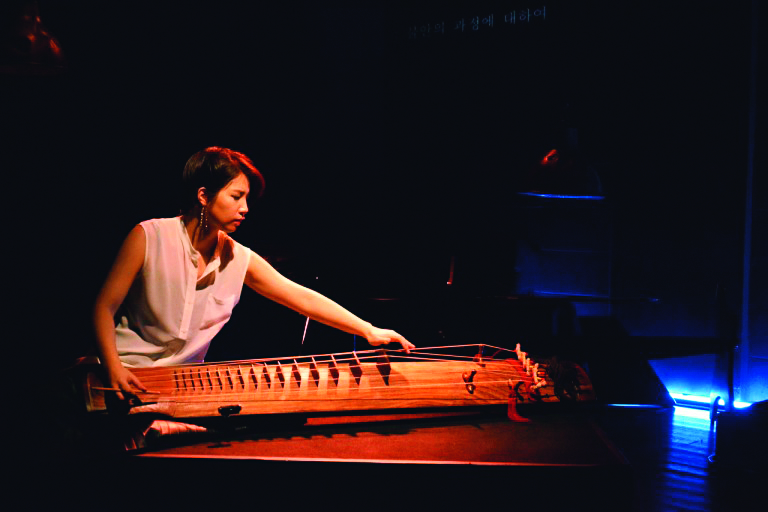
The geomungo, a six-ed zither, has long been considered the finest of all Korean musical instruments, used not only to play music but as a tool for mental cultivation and mind control. At first glance, it resembles the gayageum, a 12-ed zither. Both are built of wood with silk s, but they are completely different – especially in tone – as the result of their construction and the way they are played. The gayageum is played by pressing down on the s and plucking them by hand. The geomungo has thicker s and produces a low, ponderous sound; it is played by plucking the s with a stick, called
suldae, in one hand while the other hand pulls or pushes on the s. This combination of percussion and s emits a more restrained but stronger sound than otherinstruments.
The geomungo had a key role in traditional ensembles. In modern times, its importance has gradually declined and creative new pieces highlighting the instrument are rare. There are various reasons for this, but given the current prevalence of bands and Western-style orchestras, it is primarily because the geomungo’s low volume and simple tones dissuade them from investing in efforts to incorporate the instrument on their playlist.
Certainly, it isn’t easy toa piece that fully demonstrates the particulars of the geomungo. But that hasn’t stopped some musicians from garnering acclaim with the geomungo alone. Hwang Gina, geomungo soloist and music creator, makes sensuous, contemporary works that expand the possibilities of this instrument. Her digital single, “Mess of Love,” released in 2021, expresses the conflicting psychology of men and women dealing with separation. The geomungo delivers rhythmically paced entertainment that feels just right.
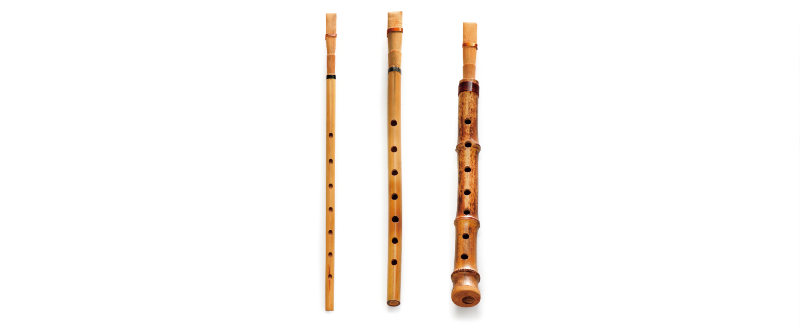
Piri
Life Breathed into Wood
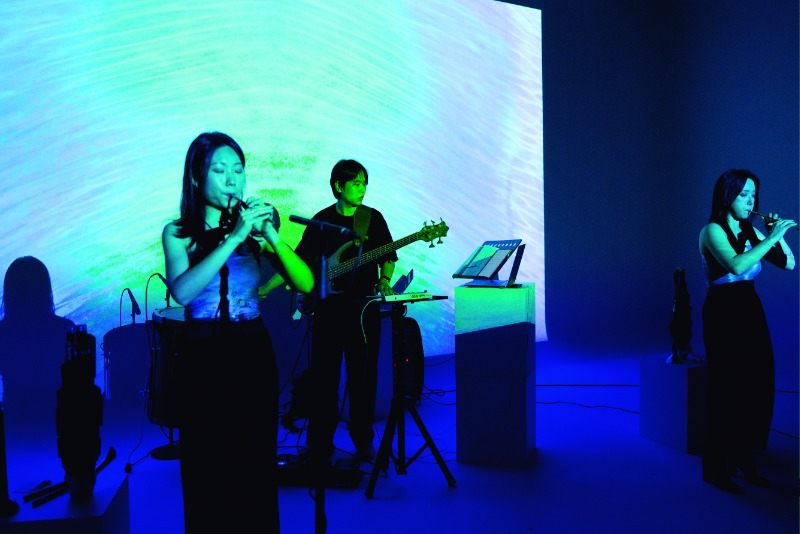
Some instruments come to life when the p’s breath is channeled through a wooden bore. The piri is a vertical bamboo instrument comparable to an oboe. There are three types based on size and function:
hyangpiri, literally the “local piri,” which is the longest type of piri; the slender
sepiri; and
dangpiri, or the “Tang piri,” which was used mainly to play court music and music derived from China.
The piri plays the main melody in most traditional Korean music, from palace music to folk music. In general, wind instruments are divided into those with a reed (a thin piece of material that vibrates to produce sound) and those without. The piri has a double-reed called “seo” and is played by breathing into the bore, controlling strength, and opening and closing the tone holes (jigong) with the fingers. The musician uses the tongue or adjusts the position of the reed to control the pitch, and performs various techniques that can only be done on the piri. Full utilization of these features requires both sensitivity and skill.
The piri can play quite a wide spectrum of music. Thanks to its firm and powerful timbre, it is also often responsible for the main melody in contemporary works. Surprisingly, however, ensembles consisting solely of piri ps are rare. BBIRIBBOO, a three-member band consisting of two piri ps and one producer, is one of the exceptions. They emphasize the charm of the piri with witty and innovative interpretations of a diverse traditional repertoire.
“In Dodri,” released in 2021, is a funky rearrangement of “Yangcheong Dodeuri,” one of the three pieces making up “Celebrating Eternity” (Cheonnyeon Manse), a classical suite played at court banquets of the Joseon Dynasty (1392-1910). It has a fast tempo and high-spirited, catchy melodies. Borrowing and interpreting these attributes, “In Dodri” is performed with the piri and saenghwang, a free-reed mouth organ.
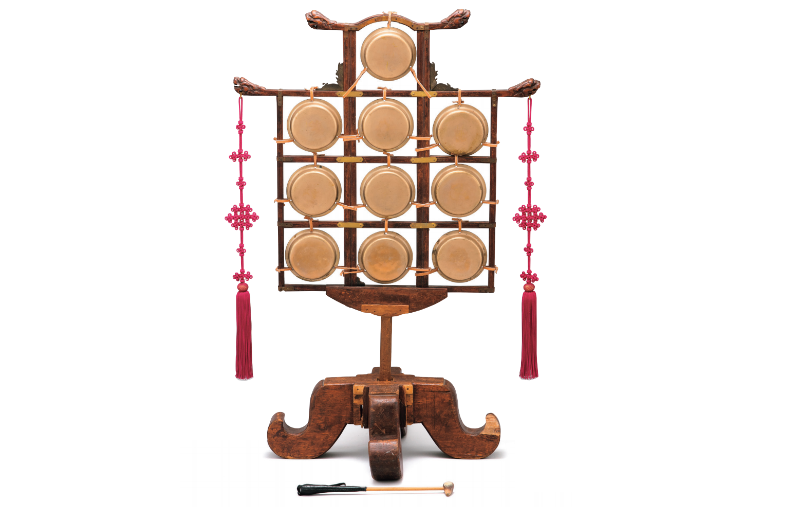
Ulla
Vibration and Resonance
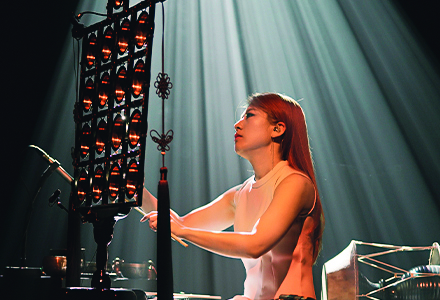
he ulla is a relatively new traditional Korean instrument. It was introduced from China, but no definitive date has been confirmed. It isn’t mentioned in the major music book of the early Joseon Dynasty, “Canon of Music” (Akhak gwebeom), first published in 1493, but can be found in historical sources from the latter half of the Joseon period.
The ulla is a percussion instrument consisting of 10 small copper gongs hung in a wooden frame. A small rod, held in one or both hands, is used to strike the gongs, which are arranged in four rows, the pitch of each gradually increasing from bottom to top and left to right. Unlike most other percussion instruments, the ulla can play melodies. However, it is usually played in a percussion ensemble and solo pieces for the ulla are rare. Today, this instrument is mainly used in processional music to accompany the changing of the guard ceremony at royal palaces or reenactments of a royal procession.
Percussionist Han Solip has recently introduced notable pieces for the ulla and other percussion instruments. Her first digital single, “All Grownups Were Once Children,” released in 2018, features the clear, pure tones of the ulla in an overall warm and dreamy atmosphere. This solo piece has a distinctly different feel from traditional processional music as it focuses on gentle reverberations and lyrical melodies rather than the clear, piercing sound the gongs make when struck strongly. Many more musicians are expected to explore the possibilities of this traditional percussion instrument with its modern, minimal sound in the years ahead.
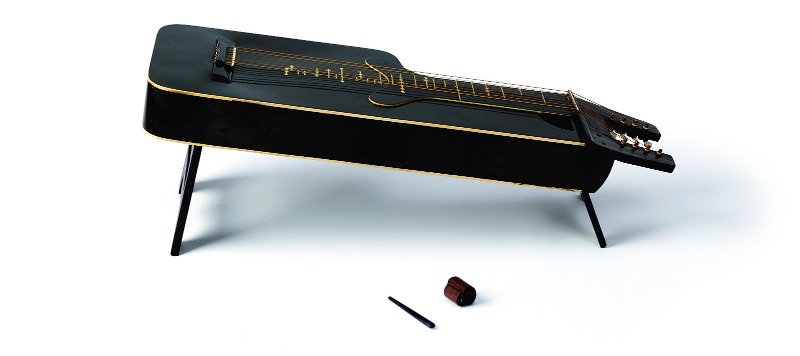
© Choi Yeong-mo
Cheol-hyeongeum
The Guitar Morphed
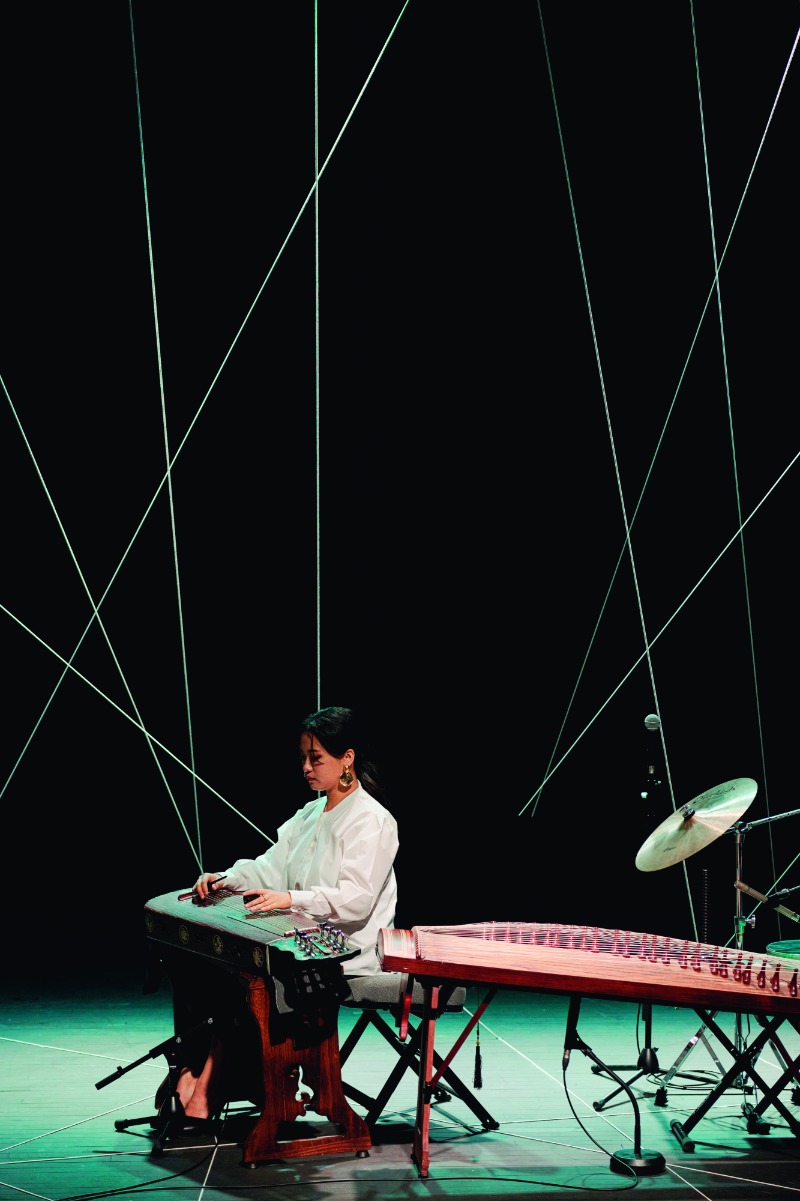
The cheol-hyeongeum is a steel-ed zither devised by Kim Yeong-cheol, a master tightrope walker and member of a
namsadangpae, a traditional band of itinerant male entertainers, during the 1940s. It is a rare example of a guitar modified to suit the grammar of traditional Korean musical instruments. The instrument is said to have been made while Kim played the guitar for fun, laying it on the floor like a geomungo. Consequently, the qualities of the guitar and the geomungo were beautifully combined.
Koreaninstruments are typically made with silk threads, but the cheol-hyeongeum has eight steel s, like some guitars. It is played like the geomungo: a stick called suldae is held in the right hand to pluck the s while the left hand moves a slide along the s. The result is a completely different tone from a guitar with steel s. Straddling a subtle boundary between instruments, it is infused with modern vitality and the energy of change.
The cheol-hyeongeum is not a common instrument among performers of traditional music, and few specialize in playing it. Naturally, there are very few pieces composed for it. Recently, there have been increasing opportunities to hear the instrument in new, creative works. For example, it appears around the middle of “The Waves of the Neocortex,” a 2019 piece by the gayageum trio Hey , producing metallic melodies – sharp but rounded – that contrast with gayageum melodies.

© Song Kwang-chan
Janggu
The Start and End of Music
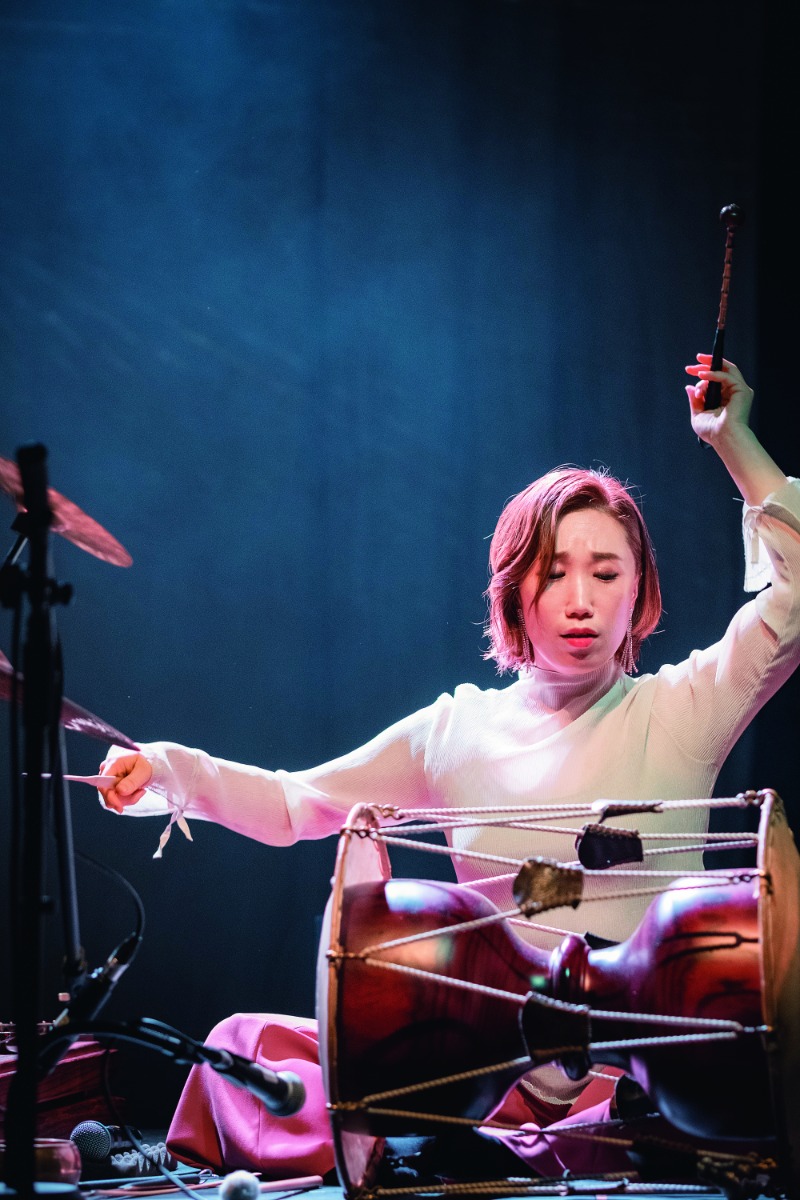
The janggu is a double-headed drum widely used in traditional Korean music. It is almost always played at both the beginning and end of a piece, due to its role in control ling the tempo with the beats. This drum is made by gouging out the inside of a long log at its ends and forming a slender stem in the middle. The result is an hourglass shape, with both ends covered with leather and fastened with s. It is played by beating on the leather heads: the left side with the palm of the hand or a rounded mallet called
gungchae and the right side with a long, thin wooden stick called
yeolchae.
The janggu is basically considered an accompanying instrument. There are, of course, pieces that showcase the vibrant and dazzling melodies and techniques of the janggu, such as the seoljanggu (display of individual feats) and pungmulgut (farmers’ band parade). However, not often is a piece of music written entirely for percussion instruments. Recently, however, there have been an increasing number of percussion soloists, expanding the scope of their music beyond conventional boundaries.
Kim So Ra is one such soloist. Her second album, “Landscape,” released in 2021, presents her own spin on the rhythms of traditional farmers’ percussion band music and shamanic music. Her performances are characterized by both explosive energy and restrained beauty. Her music provides a precious opportunity to appreciate a janggu performance as one full score.